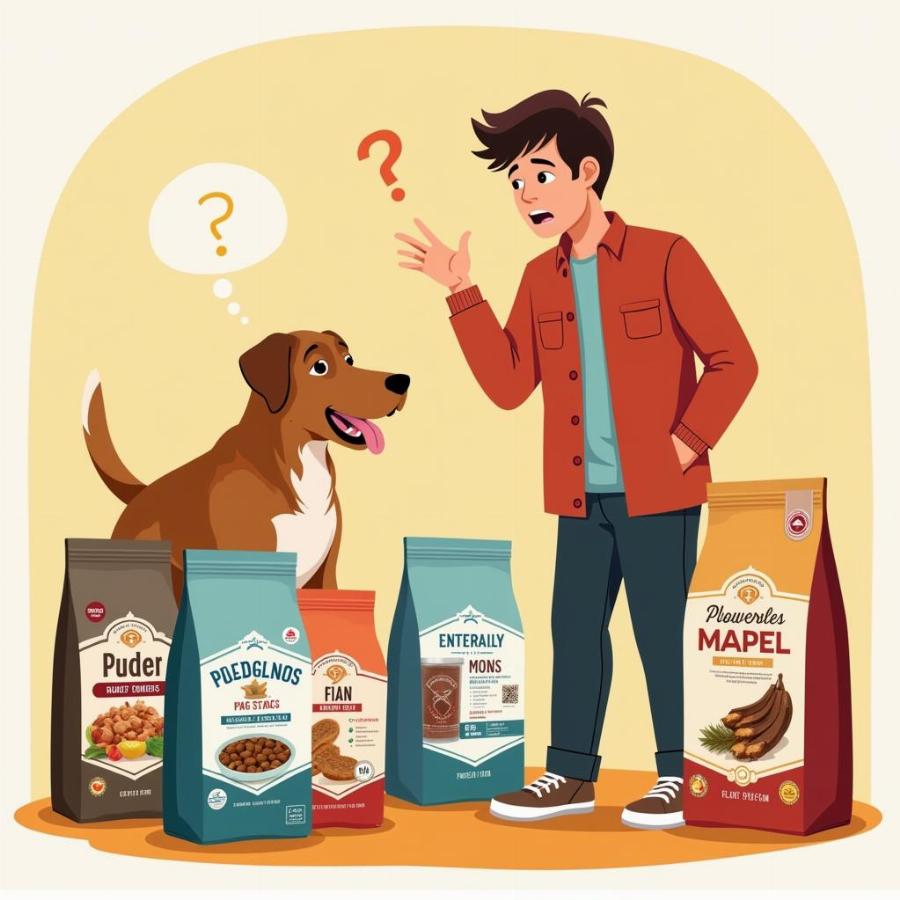Finding the best dry dog food for food allergies can be a challenging but crucial step in ensuring your furry friend’s health and happiness. Food allergies can manifest in a variety of ways, from itchy skin and ear infections to digestive upset. Choosing the right dry dog food can significantly alleviate these symptoms and improve your dog’s quality of life. This article will guide you through selecting the best dry dog food for your allergy-prone pup, covering key ingredients, common allergens, and helpful tips for managing food sensitivities.
 Choosing dry food for dogs with food allergies
Choosing dry food for dogs with food allergies
Understanding Food Allergies in Dogs
Food allergies are adverse reactions to specific proteins found in dog food. Unlike food intolerances, which primarily affect the digestive system, true food allergies trigger an immune system response, leading to a range of symptoms. Common allergens include beef, chicken, dairy, eggs, wheat, soy, and corn. Identifying the specific allergen causing your dog’s discomfort is crucial for effective management.
Common Signs of Food Allergies
- Itchy skin and excessive scratching
- Chronic ear infections
- Gastrointestinal issues (vomiting, diarrhea)
- Hair loss
- Skin redness and inflammation
Choosing the Best Dry Dog Food for Food Allergies
Selecting the right dry dog food involves careful consideration of ingredients and allergen sources. Look for hypoallergenic formulas that use novel protein sources like venison, duck, or kangaroo, or hydrolyzed protein sources where the protein has been broken down into smaller pieces less likely to trigger an allergic reaction.
Key Ingredients to Look For:
- Novel proteins: Meats your dog hasn’t been exposed to before, minimizing the risk of allergic reactions.
- Hydrolyzed proteins: Proteins broken down into smaller pieces, reducing their allergenicity.
- Limited ingredient diets: Formulas with fewer ingredients to help pinpoint potential allergens.
- Grain-free options: Eliminates common grain allergens like wheat and corn.
How to Transition to a New Food
Introducing a new food should be gradual to avoid digestive upset. Start by mixing a small amount of the new food with your dog’s current food, gradually increasing the proportion of the new food over several days.
Working with Your Veterinarian
It’s essential to consult with your veterinarian before making any dietary changes. They can help diagnose the specific allergen causing your dog’s allergies and recommend the best course of action, which may include an elimination diet or allergy testing. They can also advise on the best dry dog food for dogs with food allergies.
“Identifying the root cause of food allergies is crucial for effective management. A proper diagnosis, often involving an elimination diet, can significantly improve a dog’s quality of life,” says Dr. Emily Carter, DVM, a veterinary dermatologist.
Conclusion
Choosing the best dry dog food for food allergies involves understanding the common allergens, selecting hypoallergenic formulas with novel or hydrolyzed proteins, and working closely with your veterinarian. By following these guidelines, you can help your furry friend live a happier, itch-free life. Don’t hesitate to explore best dry dog food for skin allergies for more information on managing skin-related food allergies.
FAQ
- What are the most common dog food allergens? Beef, chicken, dairy, eggs, wheat, soy, and corn are common culprits.
- What is a novel protein? A novel protein is a meat source your dog hasn’t been exposed to before, like venison or duck.
- How do I transition my dog to a new food? Gradually mix the new food with the old food over several days.
- Should I consult with my veterinarian? Yes, it’s crucial to consult with your vet for diagnosis and dietary recommendations.
- What are the signs of a food allergy in dogs? Itchy skin, ear infections, digestive upset, and hair loss are common signs.
- What is hydrolyzed protein? Hydrolyzed protein is protein broken down into smaller pieces, making it less allergenic.
- What are the benefits of a limited ingredient diet? It helps pinpoint potential allergens by minimizing the number of ingredients.
Beaut Dogs is your trusted source for all things related to dog care, offering expert advice and comprehensive information on various breeds, health, nutrition, and training. For personalized support regarding your dog’s food allergies, contact us at Email: [email protected]. We are dedicated to helping you provide the best care for your beloved companion. Visit us at https://beautdogs.com to explore our resources and learn more.